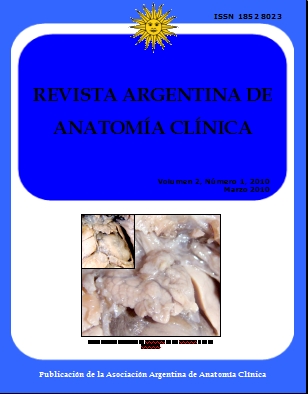ESTUDIO ANATÓMICO EN FETOS HUMANOS: DIVISIÓN DEL NERVIO CIÁTICO Y SU RELACIÓN CON LA TÉCNICA ANESTÉSICA DE WINNIE A NIVEL GLÚTEO. ANATOMICAL STUDY IN HUMAN FETUSES: SCIATIC NERVE DIVISION RELATED TO WINNIE´S ANAESTHETIC APPROACH AT GLUTEAL LEVEL
DOI:
https://doi.org/10.31051/1852.8023.v2.n1.13860Palabras clave:
Técnicas anestésicas, miembro inferior, vaina del nervio ciático, Anesthetic procedures, lower limb, sciatic sheathResumen
Introducción: El nervio ciático nace por la unión de todas las raíces del plexo sacro, sale de la pelvis por la parte inferior de la incisura isquiática mayor, desciende siguiendo la línea media en la región posterior del muslo y se divide en nervios tibial y peroneo, generalmente, a nivel del ángulo superior de la fosa poplítea. No obstante, es posible que se divida en cualquier punto de su recorrido, por lo que los bloqueos anestésicos que se realizan en la región glútea podrían ser insuficientes. Objetivo: Investigar el origen de los nervios tibial y peroneo, sus variantes en el trayecto hacia la región poplítea y su relación con la efectividad de la anestesia mediante el abordaje de Winnie. Material y Método: Se disecaron 50 fetos humanos (88 extremidades inferiores), fijados por inmersión en solución de formol, de entre 10 y 26 semanas de gestación y ambos géneros. Resultados: El nervio ciático se divide en nervios tibial y peroneo del siguiente modo: a) dentro de la fosa poplítea, en el 73,9% de los casos, b) en la región del muslo posterior, en el 11,4% de los casos, c) en la región glútea, en el 4,5% de los casos, y d) nunca se constituye el nervio ciático, en el 10,2%. Conclusión: El bloqueo anestésico puede ver reducida su eficacia cuando se utiliza el abordaje glúteo como ocurre en la Técnica de Winnie, dado que se podría bloquear solamente uno de los troncos del nervio ciático.
Introduction: The sciatic nerve originates by the junction of the sacral plexus roots, leaves the pelvis through the lower side of the greater ischiatic foramen, continues downwards along the medial line of the posterior region of the thigh and divides into tibial and peroneal nerves usually at the upper angle of the popliteal fossa. But that division may happen in upper levels and cause an incomplete anesthetic block in gluteal region. Our objective was to determine the origin of the tibial and peroneal nerves, its variations and the relation with the effectiveness in the anesthetic block by Winnie’s approach. Material and Method: We dissected 50 human fetuses (88 lower limbs), between 10 to 26 weeks of gestation, of both genders and fixed by immersion in formaldehyde solution. Results: The sciatic nerve divides into tibial and peroneal nerves in the following way: a) inside the popliteal fossa, 73.9% of the cases, b) in the posterior region of the thigh, 11.4% of the cases, c) in the gluteal region, 4.5% of the cases, and d) those cases in which there is not a sciatic nerve, in the 10.2%. Conclusion: The anesthetic block may reduce its effectiveness in gluteal approach, as it happens in Winnie’s approach, if only one of the sciatic nerve branches is involved.
Referencias
Bollini CA, Moreno M. 2004. Bloqueo del nervio ciático. Revista Argentina de Anestesiología 62: 476-86.
Casals Merchán M, Eshan F, Martínez Mañas F, Murga Marquínez V, Alonso Gómez A, Frascari Messina A, Soto Ejarque JM, Vidal Prat F, Bausili Pons JM. 2000. Sciatic nerve block. Description of a new posterior approach in the gluteal area. Rev Esp Anestesiol Reanim 47: 245-51.
Conolly C, Coventry D. 1998. Combined sciatic/femoral block followed by sciatic infusion of ropivacaine 2mg/ml for below knee amputation; a feasibility study. Regional Anesthesia and Pain Medicine 23: 81-85.
Cuvillon P, Ripart J, Jeannes P, Mahamat A, Boisson C, L'Hermite J, Vernes E, de la Coussaye JE. 2003. Comparison of the parasacral approach and the posterior approach, with single and double-injection techniques, to block the sciatic nerve. Anesthesiology 98: 1436-41.
Franco C. 2003. Posterior approach to the Sciatic nerve in adults: Is Euclidean geometry still necessary? Anesthesiology 98: 723-8.
Güvençer M, Akyer P, Iyem C, Tetik S, Naderi S. 2008. Anatomic considerations and the relationship between the piriformis muscle and the sciatic nerve. Surg Radiol Anat 30: 467-74.
Lall K, Dhar P. 2007. A case of unilateral high division of sciatic nerve and bipartite piriformis muscle. International Medical Journal, 14: 55-8.
Latarjet M, Ruiz Liard A. 1995. Anatomía Humana. 3a Edición, México: Editorial Médica Panameri-cana, pág: 936-43.
Reina MA, López A, De Andrés JA. 2002. Adipose tissue within peripheral nerves. Study of the human sciatic nerve. Rev Esp Anestesiol Reanim 49: 397-402.
Ugrenovi? S, Jovanoviæ I, Krstiæ V, Stojanoviæ V, Vasoviæ L, Antiæ S, Pavloviæ S. 2005. The level of the sciatic nerve division and its relations to the piriform muscle. Vojnosanit Pregl 62: 45-9.
Williams PL, Warwick R, Dyson M, Bannister LH. 1995. Gray's Anatomy. 31th ed, New York: Churchill Livingstone, pág: 1143-53.
Descargas
Publicado
Número
Sección
Licencia
Los autores/as conservarán sus derechos de autor y garantizarán a la revista el derecho de primera publicación de su obra, el cuál estará simultáneamente sujeto a la Licencia de reconocimiento de Creative Commons que permite a terceros compartir la obra siempre que se indique su autor y su primera publicación en esta revista. Su utilización estará restringida a fines no comerciales.
Una vez aceptado el manuscrito para publicación, los autores deberán firmar la cesión de los derechos de impresión a la Asociación Argentina de Anatomía Clínica, a fin de poder editar, publicar y dar la mayor difusión al texto de la contribución.



